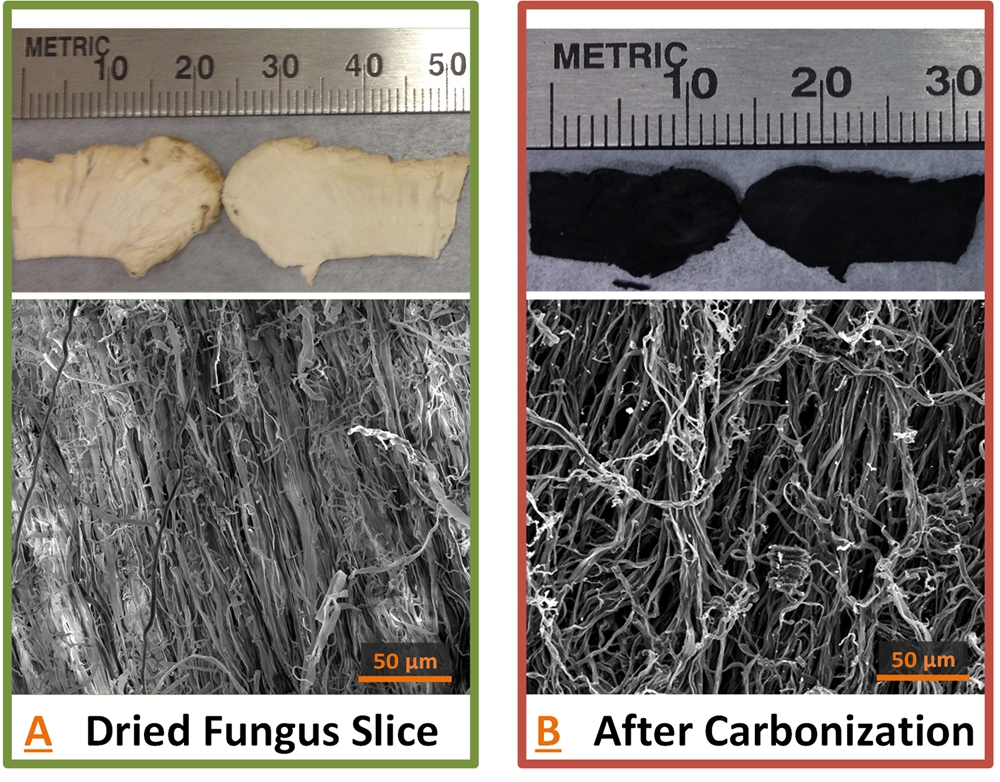 我们可以在显微镜下看到野生菌类(如图)内部“错综复杂”的纤维网络,这使其成为了一种非常理想的电极材料。(普渡大学/Jialiang Tang)
我们可以在显微镜下看到野生菌类(如图)内部“错综复杂”的纤维网络,这使其成为了一种非常理想的电极材料。(普渡大学/Jialiang Tang)
最近,研究人员从一种野生菌类中发现了一种新型碳纤维材料。这种材料经过纳米颗粒改性,与锂离子电池中最为常见的石墨电极相比,可以呈现出更佳的表现。
据了解,这种野生菌类名为硫磺干酪菌(Tyromyces Fissilis),美国普渡大学(Purdue University)的研究人员正是以这种菌类为原材料,成功制造了一种新型电极。
“为了满足未来电动汽车和电网的储能需求,即使现阶段最为先进的锂离子电池也必须从能量密度与功率输出两个方面进行优化。”普度大学化学工程与材料工程学院副教授Vilas Pol表示,“因此,现在急需开发拥有更高性能的新型电极材料。”
锂电池中的锂离子存在于电解质之中,但在充电阶段,锂离子是存储在电极中的,而目前绝大多数锂离子电池采用的电极材料均为石墨。
Pol教授与博士生Tang Jialiang发现,从硫磺干酪菌中提取的碳纤维材料,经过氧化钴纳米颗粒的改性后,性能优于传统石墨电极材料。Pol教授表示,这种混合设计的优异表现是一种协同作用的结果。
他说,“碳纤维和氧化钴颗粒均具有电化学活性,两者都能参与到反应之中,因此可以提高电极的容量。”
这种新型混合电极的容量很稳定,约为530毫安/克,比石墨电极的容量高1.5倍。
为了提高电池的性能,一种方法是通过添加特定的金属对碳纤维进行改性,比如合金或金属氧化物就允许电极在电池充电时,存储更多的锂离子。据了解,在读博士Tang一直在寻找碳纤维的替代材料,并在探索的过程中发现了这种菌类原材料。
Tang表示,“现阶段,生产电池所需碳纤维材料的过程过于依赖化学过程,而且成本高昂。”
他发现自家后院中一截腐烂的树桩上长出了一种菌类,并决定探索以这种菌类为原材料,生产碳纤维的可能性。
“我对这种菌类的结构很好奇,所以把它切了开来,然后发现这种菌类的属性非常有趣。”他说。“这种菌类很类似橡胶,但同时也非常结实。最有趣的是,当你把它切开后,会发现这种菌类拥有一种纤维性的网状结构。”
与其他菌类相比,硫磺干酪菌中的纤维非常丰富,而这些纤维可以在高温氩气室中发生热解反应,生成真菌纤维状的纯碳。
这些纤维交缠在一起,并没有什么顺序,就像一盘意大利面一样。
Pol表示,“这些纤维可以构成一个导电的互联网络。”
由于这个网络传输电子的速度更快,因此可以提高电池的充电速度。
作者:Jean L. Broge
来源:SAE《航空工程》杂志
翻译:SAE 上海办公室
Fungus-inspired improvements in battery performance
Carbon fibers derived from a sustainable source, a type of wild mushroom, and modified with nanoparticles have been shown to outperform conventional graphite electrodes for lithium-ion batteries.
Researchers at Purdue University have created electrodes from a species of wild fungus called Tyromyces fissilis.
"Current state-of-the-art lithium-ion batteries must be improved in both energy density and power output to meet the future energy storage demand in electric vehicles and grid energy-storage technologies," said Vilas Pol, an Associate Professor in the School of Chemical Engineering and the School of Materials Engineering. "So there is a dire need to develop new anode materials with superior performance."
The anodes in most of today's lithium-ion batteries are made of graphite. Lithium ions are contained in an electrolyte, and those ions are stored in the anode during recharging.
Pol and doctoral student Jialiang Tang have found that carbon fibers derived from Tyromyces fissilis and modified by attaching cobalt oxide nanoparticles outperform conventional graphite in the anodes. The hybrid design has a synergistic result, Pol said.
"Both the carbon fibers and cobalt oxide particles are electrochemically active, so your capacity number goes higher because they both participate," he said.
The hybrid anodes have a stable capacity of 530 mAh/g, which is one and a half times greater than graphite's capacity.
One approach for improving battery performance is to modify carbon fibers by attaching certain metals, alloys or metal oxides that allow for increased storage of lithium during recharging. Tang got the idea of tapping fungi for raw materials while researching alternative sources for carbon fibers.
"The methods now used to produce carbon fibers for batteries are often chemical heavy and expensive," Tang said.
He noticed a mushroom growing on a rotting wood stump in his backyard and decided to study its potential as a source for carbon fibers.
"I was curious about the structure so I cut it open and found that it has very interesting properties," he said. "It's very rubbery and yet very tough at the same time. Most interestingly, when I cut it open it has a very fibrous network structure."
Comparisons with other fungi showed the Tyromyces fissilis was especially abundant in fibers. The fibers are processed under high temperatures in a chamber containing argon gas using a procedure called pyrolysis, yielding pure carbon in the original shape of the fungus fibers.
The fibers have a disordered arrangement and intertwine like spaghetti noodles.
"They form a conductive interconnected network," Pol said.
The interconnected network brings faster electron transport, which could result in faster battery charging.
Author: Jean L. Broge
Source: SAE Aerospace Engineering Magazine
等级
打分
- 2分
- 4分
- 6分
- 8分
- 10分
平均分
